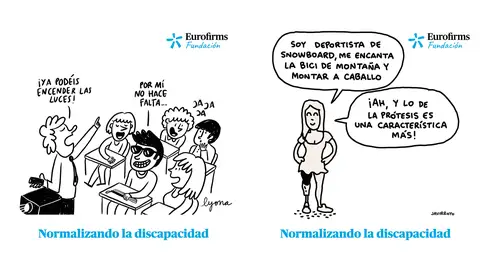Through an internal communication action, the Company echoes the #IgualDeDiferentes campaign of Eurofirms Foundation and shares with its workers illustrations that show some real situations that people with disabilities experience every day, as well as a series of tips to create more inclusive world. Because the first step to normalize disability is to know it better.
As a company committed to diversity, Atresmedia works with the objective of normalizing the presence of people with disabilities in its different formats, as well as in its advertising communications, to give voice to their reality and achieve their full inclusion in society.

- A new approach
In the first illustration we can find Isaac, whose sight (but not sharpness) was taken away by a traffic accident. He loves to use his sense of humor to naturalize disability and escape the paternalism and compassion with which he is so often treated.
Tips for a better treat: If we avoid overprotective attitudes, people with disabilities will present themselves as they really are and feel themselves included. Likewise, understanding its limitation as something specific and adapting the environment will make disappear all those obstacles encountered.
- An inclusive language
The second illustration shows Astrid: fighter, brave and tremendously smiling, with a personality that captivates you. She is not defined as a disabled person, but as a person with a disability. Her prosthesis are just one more feature for her. It is clear that, above her limitation, there are great attributes, aptitudes and capacities that make her unique.
Tips for a better treat: It is important to understand that disability does not define the person, it is just one more characteristic. Our language builds realities, so we should always use "people with disabilities" or "functional diversity", instead of terms such as "disabled" or "handicapped" that have a negative connotation.

- Capabilities
With this third illustration we ask ourselves: Can disability be a determining factor when looking for a job? Taking into account the eight selection processes that Eva went through last year, it seems so. All interviewers spent more time finding out what disability she had than knowing her skills for the position.
Tips for a better treat: When we interact with a person with a disability, do we pay attention to their abilities? Where do we put the focus? By focusing on skills, we will build their self-confidence and the ability to show their best. On the other hand, there are also some stereotypes that have been statistically denied such as "they have a higher rate of absenteeism" and "they perform at a lower level", which means that in Spain only 34.5 % of people with disabilities have a job. Being aware of prejudices will help us to have a more inclusive look.
- Promoting their autonomy:
As we see in the fourth illustration, sometimes it is difficult to know which bus to take, especially when someone decides it for you. José Antonio told us that a couple of months ago he almost took a trip to the other side of the city, thanks to the impetus of a friendly neighbor. Respect comes from asking, even before doing a supposed good deed.
Tips for a better treat: When we observe a situation in which a person with a disability may need help, we suggest you to ask them before acting. If they can carry out an action autonomously, they will appreciate your predisposition, but will also appreciate that you trust in their possibilities. To consider their autonomy is to recognize and dignify it.
Next, we leave you other real and everyday situations that people with disabilities experience, and with which we invite you to think on how you normalize disability to build a more inclusive world.


